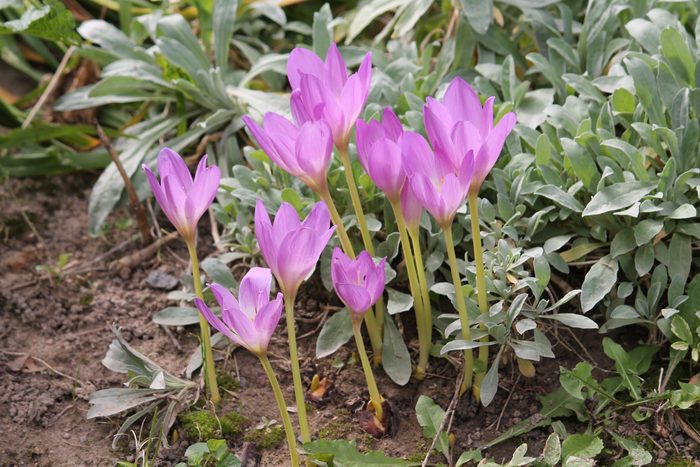Guide To Growing Autumn Crocuses and Colchicums
Updated: Oct. 19, 2023

Although they look like spring flowers, I'm delighted to see the flowers of colchicums and autumn crocuses blooming in my garden every fall.
In my garden, the first colchicum flowers come up in late summer, a sure sign fall is near. They’re soon followed by another fall flower, the autumn crocus. It looks a lot like the crocuses we see in the spring, but without the leaves.
I love seeing both pop up, although their arrival is another sign winter is coming. With mostly purplish to pink blooms, they stand out in my garden, especially among the colors of fallen leaves.
On This Page
What Are Colchicums?
Colchicums are often called autumn crocuses, but they’re a different flower. Most for sale are native to parts of Europe and carry the botanical name Colchicum autumnale. They’re mostly hardy in U.S. Department of Agriculture (USDA) Plant Hardiness Zones 4 through 8.
The leaves remind me of hostas. They come up in spring and gradually die back by early summer. The flowers pop up in late summer and early fall. In my garden, in USDA Zone 6a, I often see the first colchicum flowers in late August and early September.
What are Autumn Crocuses?
Autumn crocuses (aka fall-blooming crocuses), with the botanical name Crocus speciosus, are native to areas of Turkey, Crimea and northern Iran. They’re mostly hardy in Zones 5 through 9.
Like colchicums, the autumn crocus foliage comes up in spring. But it’s narrow, like a thick grass. The foliage dies back by early summer, then flowers appear in September and October. They are often in bloom in my garden on Halloween!
Where Do Autumn Crocuses and Colchicums Grow Best?
Both like full sun to light shade and well-drained soil. Mine grow near deciduous trees where they get mostly full sun in the spring while their leaves are growing. Then, when they flower, fallen tree leaves support the blooms and keep them from flopping over.
When choosing a spot for colchicums especially, keep in mind that during late spring and summer, the foliage will gradual die back. I don’t mind seeing that because I know what’s coming in fall. But if it bothers you, plant colchicums with a ground cover that will hide that foliage.
Types of Autumn Crocuses and Colchicum
There are several varieties of autumn crocuses and colchicums available from many bulb companies like Brent and Becky’s Bulbs in Virginia. A few to consider include:
- Colchicum ‘Waterlily’: Has double the number of petals, making it look like a water lily flower.
- Colchicum ‘Giant’: Larger flowers and can grow up to 10 inches tall.
- Colchicum ‘Album’: White flowers.
- Crocus speciosus ‘Albus’: White flowers with a yellow center.
- Crocus speciosus ‘Oxonian’: Darker purple flowers.
- Crocus speciosus ‘Conqueror’: Bluer flowers.
One other fall-blooming crocus to consider: the saffron crocus, Crocus sativus. The red threads, the stigma part of the flower, are the expensive spice saffron.
How To Plant Autumn Crocuses and Colchicums
Both autumn crocus and colchicum grow from corms. Plant the corms as soon as you get them. They’re usually shipped in late summer.
Colchicum corms are bigger than crucus corms and should be planted about six inches deep. Crocus corms should go about three inches deep. Both often bloom the same fall they’re planted.
How To Care for Autumn Crocuses and Colchicums
After planting, they don’t require much care. Avoid overwatering, which can cause the corms to rot.
How To Divide Autumn Crocuses and Colchicums
Colchicums and autumn crocuses gradually spread out from where they are, producing more corms underground. Dig them up and divide them to share just as the foliage dies back. At that point, you can still see where they are.
Dig up the whole clump of dying foliage, separate the corms, then replant some in the same spot and spread the others around. Or share them with friends. Many of my favorite colchicums came from friends who generously shared them with me!
